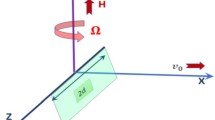Abstract
This paper investigates the inverse problem of determining a heat source in the parabolic heat equation using the usual conditions of the direct problem and a supplementary condition, called an overdetermination. In this problem, if the heat source is taken to be space-dependent only, then the overdetermination is the temperature measurement at a given single instant, whilst if the heat source is time-dependent only, then the overdetermination is the transient temperature measurement recorded by a single thermocouple installed in the interior of the heat conductor. These measurements ensure that the inverse problem has a unique solution, but this solution is unstable, hence the problem is ill-posed. This instability is overcome using the Tikhonov regularization method with the discrepancy principle or the L-curve criterion for the choice of the regularization parameter. The boundary-element method (BEM) is developed for solving numerically the inverse problem and numerical results for some benchmark test examples are obtained and discussed
Similar content being viewed by others
References
Cannon J.R., and Zachman D. (1982). Parameter determination in parabolic partial differential equations from overspecified boundary data. Int. J. Engng. Sci. 20:779–788
Prilepko A.I., and Solov’ev V.V. (1988). Solvability theorems and Rote’s method for inverse problems for a parabolic equation I. Diff. Equ. 23:1230–1237
Solov’ev V.V. (1990). Solvability of the inverse problem of finding a source, using overdetermination on the upper base for a parabolic equation. Diff. Equ. 25:1114–1119
Savateev E.G. (1995) . On problems of determining the source function in a parabolic equation. J. Inv. Ill-Posed Problems 3:83–102
Cannon J.R. (1968). Determination of an unknown heat source from overspecified boundary data. SIAM J. Numer. Anal. 5: 275–286
Cannon J.R., and Lin Y. (1989). Determination of a parameter p(t) in some quasilinear parabolic differential equations. Inv. Probl. 4:34–45
Malyshev I. (1989). An inverse source problem for heat equation. J. Math. Anal. Appl. 142:206–218
Deghan M. (2001). An inverse problem of finding a source parameter in a semilinear parabolic equation. Appl. Math. Modell. 25:743–754
Deghan M. (2001). Implict solution of a two-dimensional parabolic inverse problem with temperature overspecification. J. Comput. Anal. Appl. 3:383–398
Ladyzhenskaya O.A., Solonnikov V.A., Ural’tseva N.N. (1968). Linear and Quasilinear Equations of Parabolic Type. AMS, Providence, Rhode Island, 648pp
Rundell W. (1980). The determination of an unknown non-homogeneous term in linear partial differential equations from overspecified data. Applic. Anal. 10:231–242
Twomey S. (1963). On the numerical solution of Fredholm integral equations of the first kind by the inversion of linear system produced by quadrature. J. Assoc. Comput. Mach. 10:97–101
Phillips D.L. (1962). A technique for the numerical solution of certain integral equations of the first kind. J. Assoc. Comput. Mach. 9:84–97
Hansen P.C. (2001). The L−curve and its use in the numerical treatment of inverse problems. In: Johnston P (eds). Computational Inverse Problems in Electrocardiology. WIT Press, Southampton, pp. 119–142
Morozov V.A. (1966). On the solution of functional equations by the method of regularization. Soviet Math. Dokl. 7: 414–417
Fatullayev A.G., and Can E. (2000). Numerical procedures for determining unknown source parameters in parabolic equations. Math. Comput. Simul. 54:159–167
Fatullayev A.G. (2005). Numerical procedures for simultaneous determination of unknown coefficients in a parabolic equation. Appl. Math. Comput. 164:697–705
Fatullayev A.G. (2002). Numerical solution of the inverse problem of determining an unknown source term in a heat equation. Math. Comput. Simul. 58:247–253
Author information
Authors and Affiliations
Corresponding author
Rights and permissions
About this article
Cite this article
Farcas, A., Lesnic, D. The boundary-element method for the determination of a heat source dependent on one variable. J Eng Math 54, 375–388 (2006). https://doi.org/10.1007/s10665-005-9023-0
Received:
Accepted:
Published:
Issue Date:
DOI: https://doi.org/10.1007/s10665-005-9023-0




